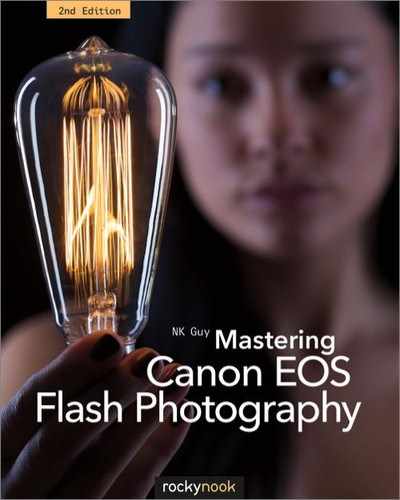4 Terminology
From Below. Most of the photos in this book have minimal post-production alterations—usually just a bit of contrast or brightness work. This is, after all, a book on flash photography and not Photoshop techniques. However, this shot required considerably more work in postprocessing. It was taken on location, not in studio, with the model standing on a sheet of clear acrylic that was inside a wooden frame built for the shot. 580EX II and shoot-through umbrella, linked to the camera with an off-camera shoe cord, to light the model. However, because a 17mm wide-angle was used, the platform frame was visible around the edges. A second shot was taken with the frame out of view, and the two pictures were combined digitally. Air Street, London, England.
This is an example of automatic off-camera wired flash.
There’s a lot of confusing and inconsistent terminology related to flash photography. For simplicity’s sake this book uses the following conventions:
AUTOFLASH
A flash unit that measures its own light output using a self-contained sensor, not through the camera. Common in the 1970s; rare today.
AUTOMATIC/AUTOMATED FLASH
Flash technology in which the light output of the flash unit(s) is controlled by a computer inside the camera.
BUILT-IN FLASH
Synonyms: popup flash and internal flash. A flash unit that’s built right into the camera body. In the case of Canon EOS cameras, an integrated flash unit that pops up from the top.
EXTERNAL FLASH
A standalone flash unit that is not built into the camera body.
FLASH
A bright pulse of light, usually produced by an electronic device, for photographic lighting.
FLASH CARD, FLASH MEMORY
A solid state (no moving parts) memory card for digital cameras.
FLASH UNIT
An electronic light-producing device used for flash photography.
MANUAL FLASH
The light output of the flash unit(s) is set directly by the photographer.
MONOLIGHT
A self-contained studio flash unit, powered by AC current.
OFF-CAMERA FLASH
A flash unit that isn’t built into or fastened to the camera itself, and is usually positioned some distance away. It may be controlled by a cable, by light or infrared signals, or by radio commands.
PACK
A box serving as a power source for a studio flash unit (see Generator, p. 31).
Canon’s trademark for its line of battery-powered flash units.
STROBOSCOPIC
Multiple bursts of light at regular time intervals, from a flash unit. A bit like a nightclub strobe light.
STUDIO FLASH UNIT
A larger flash unit designed for use in a photographic studio; usually powered by AC current.
WIRELESS FLASH
A flash unit controlled remotely without wires, and which isn’t physically connected to the camera. The command signals can be radio transmissions, pulses of light, or infrared.
The following terms aren’t used in this book because of their potential for ambiguity:
FLASHGUN
A small battery-powered flash unit.
FLASHLIGHT
A rare synonym for a flash unit, which is easily confused with a battery-powered lantern (US).
GENERATOR
(UK) A power pack for studio flash lighting (see Pack, p. 34).
MONOBLOC
(UK) A monolight.
SPEEDLIGHT
A Nikon trademark; sometimes refers generically to a small battery-powered flash unit.
STROBE
(US) Sometimes any flash unit; sometimes only an AC-powered studio flash unit.

